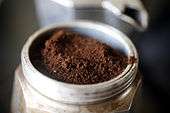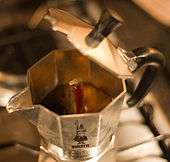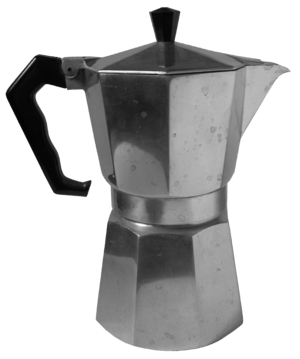Moka pot
|
Bialetti Moka Express | |
| Manufacturer | Bialetti |
|---|---|
| Release date | 1933 |
The moka pot, also known as a macchinetta (literally "small machine"), is a stove-top or electric coffee maker that produces coffee by passing boiling water pressurized by steam through ground coffee. It was patented for the first time in Italy by the inventor Luigi De Ponti for Alfonso Bialetti, in 1933.[1] Bialetti Industrie continues to produce the same model under the name "Moka Express".
The moka pot is most commonly used in Europe (especially Italy, Catalonia and Spain) and in Latin America. It has become an iconic design, displayed in modern industrial art and design museums such as the Wolfsonian-FIU, Museum of Modern Art, the Cooper–Hewitt, National Design Museum, the Design Museum,[2] and the London Science Museum. Moka pots come in different sizes, from one to eighteen 50 ml (2 imp fl oz; 2 US fl oz) servings.[3] The original design and many current models are made from aluminium with Bakelite handles.
Variations and brands
Moka pots are used over a flame or electric range and are traditionally made of aluminium, though they are sometimes made out of stainless steel or other alloys.
"Brikka" is a modified moka pot manufactured by Bialetti. It incorporates a weighted valve as a pressure regulator on top of the nozzle that allows pressure to build up inside the water tank in a manner similar to a pressure cooker. As pressure builds up more quickly in this method (since there is much less leakage of vapour) compared to the standard moka pot, it reaches the level required for water to rise through the ground coffee in a shorter time. However, the weighted valve allows pressure to accumulate and temperature to rise somewhat further before the liquid bursts through the nozzle. The result is coffee brewed at a higher pressure and temperature than the standard pot, making it more similar to espresso, and therefore with more visible crema.

"Mukka Express" is a modified moka pot also manufactured by Bialetti that allows milk to be frothed and mixed with the coffee during brewing. The name, "Mukka", is a pun on the Italian for milk-cow, mucca. Bialetti also manufactures several stainless steel moka pots, e.g. Musa, Class, and Venus.
Alessi is an Italian kitchenware manufacturer known for their moka pots. Cuisinox also markets several models of moka pots in both aluminium and stainless steel.
Also the design oriented Italian kitchenware manufacturer Serafino Zani is known for his moka pots: "Finlandia" designed by Tapio Wirkkala, "Mach" designed by Isao Hosoe and awarded with the Good Design Award (Chicago) 1993, "Thema" in stainess steel with titanium and "Genesis" in stainless steel and copper, both designed by Tarcisio Zani.
Vev Viganò is an Italian manufacturer that specialises in stainless steel moka pots. Their product lines include Kontessa, Itaca, Vespress and Carioca. In 2004 they produced a caffettiera'UFO' designed by Vinod Gangotra, designed to receive two coffee cups that sit in recesses on the upper half of the machine and collect the coffee as it's brewed. The upper part is made from cast aluminium whilst the lower from stainless steel
Bellman makes a stainless steel moka pot, the "CX-25 Series", operating at higher pressure and capable of creating a crema. It also has a wand to steam liquids, such as milk for cappuccino.[4]
The brand Volturno has been manufacturing moka pots in Argentina for many decades;[5] the name Volturno is sometimes used synonymously with moka pot there.[6]
Top Moka, another Italian manufacturer, offers two different styles of moka pots in a wide variety of colours. The more traditional Top Moka pot comes in sizes varying from two- to six-shot boilers. They also make mini moka pots in one- and two-shot sizes that use dispensing arcs rather than the standard collection chamber. Both are available with aluminium boilers for standard cooktops or titanium-alloy boilers for induction stoves.[7]
G.A.T. is also an Italian company based in Brescia involved in the production of Italian moka coffee-makers since 1986. The range of coffee-makers that G.A.T. proposes is wide and complete (more than 50 models) and it allows to choose among various products, materials and prices, following the different market needs or personal liking.
After the Second World War, the Italian Moka expanded all over the South Europe and it became the standard way of domestically making coffee. Its popularity led to non-Italian South European manufacturers making copies or new designs inspired in the original Italian design.
Brewing coffee with a moka pot



The boiler (marked A in the diagram) is filled with water almost up to the safety release valve and the funnel-shaped metal filter (B) is inserted. Finely-ground coffee is added to the filter as shown below. Then the upper part (C, which has a second metal filter at the bottom) is tightly screwed onto the base. The pot is placed on a suitable heat source, the water is brought to its boiling point, and thereby steam is created in the boiler.
A gasket ensures a tightly closed unit and allows for pressure to safely build up in the lower section, where a safety valve provides a necessary release in case this pressure should get too high (with clean filters, that should not happen).
The steam eventually reaches a high enough pressure to gradually force the surrounding boiling water up the funnel through the coffee powder and into the upper chamber (C), where the coffee is collected. Although the "boiler" on a Moka pot contains steam at elevated temperature and pressure, the water forced up through the grounds is no hotter than that used in other brewing methods - up to 90 °C, depending on the stage of extraction.[8][9]
When the lower chamber is almost empty, bubbles of steam mix with the upstreaming water, producing a characteristic gurgling noise. This "strombolian phase" allows a mixture of superheated steam and water to pass through the coffee, which leads to undesirable results, and therefore brewing should be stopped as soon as this stage is reached.[8]
Maintenance
Moka pots require periodic replacement of the rubber seal and the filters, and a check that the safety release valve is not blocked.
Moka pot dimensions

The Moka pot comes in various sizes based on the number of 50 mL (2 imp fl oz; 2 US fl oz) espresso cups they produce. The following table are the standard sizes for the Bialetti Moka Express.
| Espresso cups |
Metric units | US units | ||||
|---|---|---|---|---|---|---|
| Volume (mL) | height (mm) | base (mm) | Volume (US fl oz) | height (in) | base (in) | |
| 1 | 60 | 133 | 64 | 2 | 5 1⁄4 | 2 1⁄2 |
| 3 | 200 | 159 | 83 | 6 1⁄2 | 6 1⁄4 | 3 1⁄4 |
| 6 | 300 | 216 | 102 | 10 | 8 1⁄2 | 4 |
| 9 | 550 | 254 | 105 | 18 1⁄2 | 10 | 4 1⁄8 |
| 12 | 775 | 292 | 127 | 25 | 11 1⁄2 | 5 |
Moka coffee characteristics
The flavour of Moka pot coffee depends greatly on bean variety, roast level, fineness of grind, water profile, and the level of heat used.
Moka pots are sometimes referred to as stove-top espresso makers and produce coffee with an extraction ratio similar to (but somewhat higher than) that of a conventional espresso machine.[8] The resultant brew has increased extraction of caffeine and flavours from the grounds versus filter coffee, resulting in a stronger brew than that obtained by drip brewing. Furthermore, depending on bean variety and grind selection, Moka pots can create a foam emulsion, known as crema.
However a typical Moka coffee is extracted at relatively low pressures of 1 to 2 bar (100 to 200 kPa),[8] while standards for espresso coffee specify a pressure of 9 bar (900 kPa).[10][11] Therefore, Moka coffee is not considered to be a true espresso and has different flavour characteristics.
See also
- Coffee percolator
- Coffeemaker
- Neapolitan flip coffee pot
-
 Coffee portal
Coffee portal
Notes
- ↑ "The History - Bialetti". www.bialetti.it. Retrieved 2015-08-06.
- ↑ Greenbaum, Hilary (September 1, 2011). "Who Made That Moka Express?". nytimes.com.
- ↑ "Moka Express factsheet" (PDF). Bialetti. Retrieved 2009-03-01.
- ↑ "Bellman Cappuccino Maker reviewed". CoffeeCrew.com. Retrieved 2009-12-07.
- ↑ "Volturno - Cafeteras Express" (in Spanish). Retrieved 2010-12-15.
- ↑ "Familia de Artistas". Página/12 (in Spanish). Retrieved 2010-12-15.
sirven café de una cafeterita Volturno
- ↑ "Company home page". Top Moka. Retrieved 2012-04-02.
- ↑ López-Galilea, Isabel; De Peña, M. Paz; Cid, Concepción. "Correlation of Selected Constituents with the Total Antioxidant Capacity of Coffee Beverages: Influence of the Brewing Procedure". Journal of Agricultural and Food Chemistry. 55 (15): 6110–6117. doi:10.1021/jf070779x.
- ↑ "Espresso Italiano Certificato" (PDF). Istituto Nazionale Espresso Italiano. Retrieved 2011-01-30.
- ↑ "Espresso and classic drink Wiki". Retrieved 2011-01-30.
References
- Rombauer, Irma S.; Marion Rombauer Becker; Ethan Becker (August 1997). The Joy of Cooking. Scribner. pp. 28–29. ISBN 0-684-81870-1.
- Schnapp, Jeffrey T. (2004). "The Romance of Aluminum and Caffeine". In Brown, Bill. Things. Chicago: University of Chicago Press. pp. 209–239.
External links
![]() Media related to Stovetop espresso makers at Wikimedia Commons
Media related to Stovetop espresso makers at Wikimedia Commons

